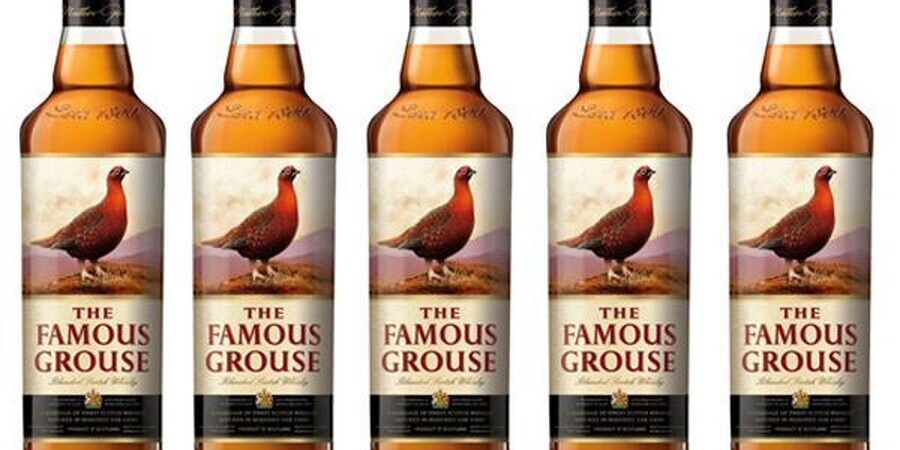Famous Grouse - Ask the Edrington Group's master blender, John Ramsay, what makes his drams different and he immediately proposes marriage. In the whisky-making sense, of course. Marriage used to be normal practice for blenders: before bottling, malts and grains would be brought together for a period of mingling. Most firms have abandoned the art, but Edrington sticks to the old ways, marrying its blends for six months and at reduced strength.
'The bean counters in most firms decided it wasn't helping the bottom line,' says John. 'But we ran an exercise to see if we were getting a benefit from marrying, and we were.' It's all down to maximizing flavor.
'When you add water to cask-strength malt, some components become unstable,' he continues. 'We give that time to settle, which means we can give the final blend a light filtration. If you don't do this you'll have to give it a harder filtration to get that stability - and then you lose some flavour'.
The process is made more complicated by his insistence on marrying blocks of blends. 'We'll combine malts and grains; reduce, marry and have Blend One,' he explains. 'Then we repeat the exercise and get Blends Two to Four. When it comes to bottling, rather than just using all of Blend One and then moving on, we'll use some from each batch. It's a form of whisky solera'.
But we skip ahead. Edrington's brands (which include Famous Grouse, Cutty Sark -which they blend for Berry Bros - Lang's Supreme and Black Bottle) start their lives as the new make samples from a host of distilleries, and are nosed by John every day. Then, like every blender, he has to work out how much new make to lay down, to satisfy potential demand for any of the brands many years down the line. It's this ability to assess new make and mature spirit that sets blenders apart.
John can stick his nose in a glass of Glenrothes 5-year-old from sherry wood and know if it fits 'the wee picture in my head', and also how that whisky will behave when combined with thirty others. While some of us may be able to pick out a few malts at a blind tasting, a blender knows not just what it is but whether it fits within the right parameters according to age and wood. It's an awesome ability, but this modest man hasn't allowed it to go to his head.
These blends are very different creatures: they don't just have different core malts, the wood recipe has also been carefully plotted. The sherry wood in the delicate Cutty comes from American oak; the richer Lang's uses Spanish oak and Grouse uses both. 'You want a fragrant sweet aroma in Cutty, so you use American wood and a Speyside malt like Tamdhu for sweetness, with some Bunnahabhain for freshness. Grouse is Speyside-based as well, but there is a lot of influence from Highland Park and the mix of sherry from Spanish and American wood'.
He uses a very Scottish analogy to describe the art of blending. 'It's like putting together a good soccer team. You need a strong central core, then you can tack the stars around that. It's useless if you haven't got that central core right.' But the unsung, hard-working midfielder in all the Edrington blends is North British grain. 'We use different grains: some for commercial reasons, but also to give different characters in the blend. We'll use Strathclyde when it's younger, as it matures quicker. North British ages well, so it will be used in older blends -it also rounds out the wood influence on older whiskies.
'A blend is a bit like a pasta with sauce,' John concludes. 'The grain is the pasta, edible but bland, and the malts are the sauce - a bit strong on their own, but together they're a great combination.' CUTTY SAR1C first made in 1923 by London wine merchants Berry Bros & Rudd, Cutty Sark was specifically made as a light-flavoured blend that would appeal to the American market, even though Prohibition was in force. It was smuggled into the United States by one Captain William McCoy and became so popular that people began demanding 'the real McCoy' as their choice of bootleg liquor.
TASTING NOTES
Cutty Sark Gentle, light nose with oat, butter, icing sugar and some delicate raspberry. A mix of cream and grass, with a touch of lemon sherbet on the finish. * * *
BLACK BOTTLE
Originally conceived by Aberdeen tea merchant Gordon Graham in the 1870s, Black Bottle passed through many different hands before landing in Highland Distillers' lap in 1995. John Ramsay has since reformulated it to be 'the malt with the heart oflslay' and uses all seven Islay malts in the blend. It's a brand to watch.
TASTING NOTES
Black Bottle 10-year-old
Islay personified: ozone, ginger, ripe fruit and ginger. With water, an intense smoky perfume leaps out, then mingles with soft cakey fruit before a blast of salt-spray halfway through. Stunning.
FAMOUS GROUSE Perth wine merchant William Gloag started blending whiskies in the 1860s, to warm the cockles of the huntin', shootin', fishin' set. In 1896 his nephew, Matthew, created The Famous Grouse. It remained a little-known classic until the 1970s, but since then has become Scotland's favourite dram, number two in the UK, and is spreading its wings into export.
TASTING NOTES
The Famous Grouse
A fat, juicy, succulent nose with a bint of menthol, lavender and a drift of smoke. Lovely weight on the palate, which is sweet, lightly spiced and tinged with peat. * * * * (*)
Also See..


